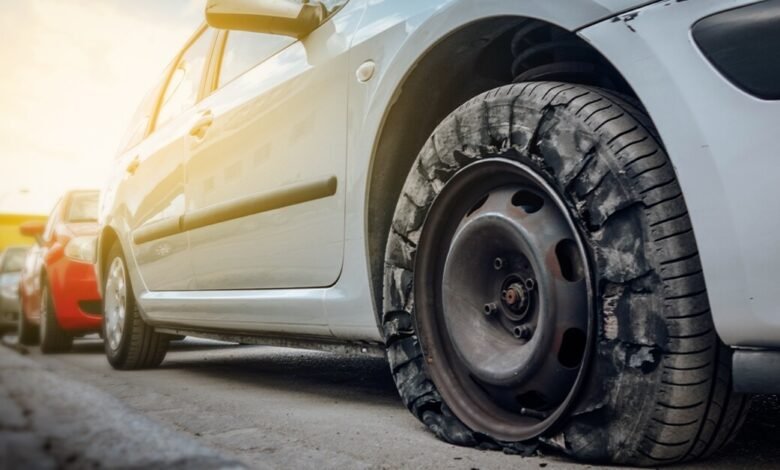
Burst Tyre pose significant risks to drivers, passengers, and other road users. Understanding the causes, recognizing warning signs, and knowing how to respond are crucial for safe driving. This comprehensive guide explores the reasons behind tyre bursts, signs indicating potential issues, immediate actions to take in case of a burst, preventive measures to reduce risks, and recovery steps post-incident.
1. Understanding Burst Tyre: Causes and Contributing Factors
Tyre Age and Wear: As tyres age, their structural integrity weakens, making them more susceptible to bursting. Wear and tear from regular use also contribute to tyre degradation.
Over-Inflation and Under-Inflation: Improper tyre inflation, whether over-inflation or under-inflation, puts excess strain on the tyre walls, increasing the risk of a blowout.
Road Hazards: Potholes, debris, sharp objects, and uneven road surfaces can puncture or damage tyres, leading to sudden bursts.
High-Speed Driving and Heat Build-Up: Excessive speeds generate heat within the tyre, which can cause the rubber to deteriorate rapidly, increasing the likelihood of a blowout.
2. Signs of a Burst Tyre: Identifying Symptoms and Warning Signals
Sudden Loss of Control or Steering: A burst tyre can cause the vehicle to pull to one side suddenly or become difficult to steer, indicating a potential blowout.
Loud Bang or Explosive Sound: A sudden and loud noise resembling an explosion may indicate a tyre blowout, especially if accompanied by vehicle vibrations.
Vehicle Vibrations or Shaking: Unusual vibrations or shaking felt through the steering wheel or vehicle chassis could signal a tyre issue, including a blowout.
Difficulty Maintaining Speed or Direction: If you find it challenging to maintain your speed or keep the vehicle on course, it could be due to a tyre blowout affecting vehicle stability.
3. Dealing with a Burst Tyre: Immediate Actions and Safety Protocols
Stay Calm and Avoid Panic Reactions: Maintain composure and focus on safely controlling the vehicle despite the sudden event.
Grip the Steering Wheel Firmly: Hold the steering wheel with both hands to maintain control and steer the vehicle in the desired direction.
Gradually Ease off the Accelerator: Release the accelerator pedal gently to decelerate the vehicle gradually, avoiding sudden braking.
Avoid Abrupt Braking or Steering Movements: Sudden braking or steering inputs can worsen the situation, potentially leading to loss of control.
Guide the Vehicle to a Safe Stopping Place: Signal and maneuver the vehicle to the side of the road or a safe location away from traffic to minimize risks to yourself and others.
4. Preventive Measures: Strategies to Minimize the Risk of Tyre Burst
Regular Tyre Inspections and Maintenance: Check tyre pressure, tread depth, and overall condition regularly, and schedule routine maintenance as recommended by the manufacturer.
Proper Tyre Inflation According to Manufacturer Recommendations: Maintain the correct tyre pressure to prevent over-inflation or under-inflation, which can weaken tyre walls.
Avoiding Overloading the Vehicle: Respect the vehicle’s load capacity limits to prevent excessive strain on the tyres, which can lead to overheating and blowouts.
Driving Defensively and Anticipating Road Conditions: Stay alert, scan the road ahead for hazards, and adjust your driving behavior to avoid potential tyre-damaging obstacles.
Investing in Quality Tyres with Adequate Tread Depth: Choose high-quality tyres with sufficient tread depth to provide better traction and durability, reducing the risk of blowouts.
5. Recovery After a Tyre Burst: Assessing Damage and Moving Forward
Inspect Tyres and Vehicle for Damage: Check all tyres for signs of damage or punctures, and assess the vehicle for any related issues, such as suspension damage.
Replace Burst Tyre with Spare or Call for Assistance: If equipped with a spare tyre and necessary tools, replace the burst tyre following safety procedures. Otherwise, seek roadside assistance for professional help.
Check for Underlying Causes or Issues: Investigate the cause of the tyre burst, such as road hazards or improper maintenance, to address any underlying issues and prevent future incidents.
Resume Driving Cautiously and Monitor Vehicle Performance: After replacing the burst tyre or receiving assistance, drive cautiously and pay attention to any changes in vehicle behavior, such as vibrations or steering abnormalities.
6.Understanding Burst Tyres:
Burst tyres can occur due to various factors, including:
- Over-Inflation: Excessive tyre pressure can cause the tyre to overstretch and weaken, making it more susceptible to bursting.
- Under-Inflation: Insufficient tyre pressure causes increased friction between the tyre and the road surface, leading to heat buildup and potential failure.
- Age and Wear: Ageing tyres or those with worn-out treads are more prone to blowouts due to structural degradation.
- Road Hazards: Potholes, debris, sharp objects, and uneven road surfaces can puncture or damage tyres, resulting in sudden bursts.
- High-Speed Driving: Driving at high speeds generates heat within the tyre, increasing the risk of tyre failure, especially if the tyre is already compromised.
7.Understanding Tyre Blowouts: Causes, Risks, and Safety Measures
A tyre blowout is a sudden and often catastrophic failure of a tyre, leading to a loss of control over the vehicle and potential accidents. Understanding the causes, recognizing warning signs, and knowing how to respond are essential for safe driving. This guide explores the factors contributing to tyre blowouts, signs indicating a potential blowout, immediate actions to take when faced with one, preventive measures to reduce the risk, and safety protocols to follow to mitigate the consequences.
Causes and Implications of Tyre Blowouts
A tyre blowout, also known as a tyre burst, is a sudden and rapid loss of air pressure within a tyre, resulting in its rapid deflation. This unexpected event can occur for various reasons and poses significant risks to drivers, passengers, and other road users. Understanding the causes, signs, and implications of tyre blowouts is crucial for ensuring road safety.
Conclusion:
Regular Tyre Maintenance is Key: Schedule regular tyre inspections, maintenance, and replacements to ensure optimal tyre health and performance.
Vigilance and Preparedness Save Lives: Stay vigilant on the road, anticipate potential hazards, and be prepared to react safely and effectively in case of a tyre-related emergency.
Prioritize Safety Over Speed: Maintain safe driving speeds and avoid aggressive maneuvers to reduce the risk of tyre damage and blowouts.
Educate Others on Burst Tyre Risks and Responses: Share knowledge about tyre maintenance, warning signs, and safe driving practices with friends, family, and fellow drivers to promote road safety awareness.




